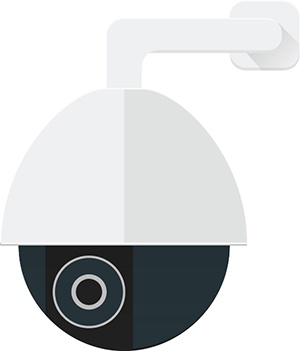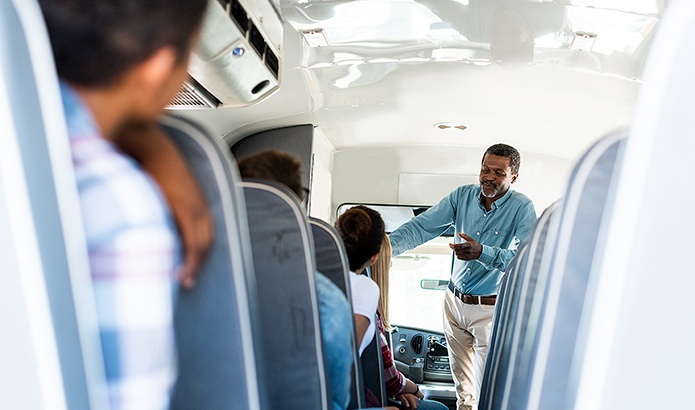

Vice President,
School Bus
Safe Fleet
Which factors should pupil transportation providers consider when spec’ing a new surveillance system?
Clint Bryer: The number one factor transportation providers should consider when spec’ing a new surveillance system is reliability. None of the other factors matter if the system is not reliable. Second to that should be to focus on areas of coverage as opposed to numbers of cameras. Some vendors can provide more coverage with less cameras than other vendors need to use.
Chris Akiyama: Selecting the right technology partner is a critical step to ensure the success of any school bus video program; we highly recommend transportation providers fully engage with potential partners to understand their ability to meet the individual needs of the school district. Consideration should be given to whether products are designed

Director of Sales, Pupil Transportation
Safety Vision
in-house, by a third party (do other products share similar hardware or software designs) or simply resold. System functionality coupled with expansion capabilities are key factors to consider as part of the evaluation process for both today and the future. Thorough evaluation of potential suppliers’ installation capabilities with projects of similar size and scope, project management, implementation timelines and support services are an integral part of the decision.
Prior to establishing specifications and moving ahead with any video surveillance investment, pupil transportation providers should conduct a thorough analysis of the intended use and needs of internal stakeholders that may be impacted by, or benefit from, the video management solution. Key areas to consider include how video is to be used and under which circumstances, who is able to access/view the video and whether any potential retention policies may already exist. A comprehensive video usage policy should be formalized and distributed to the various stakeholders so there is a clear understanding of deliverables, process and policies throughout the district, while also establishing the technical specifications that will drive both the project requirements and procurement process.
 Establishing the operational needs should directly drive the hardware specifications, especially as it relates to areas such as number of cameras, recording quality, frame rate, capacity etc. Often, some of these areas can be adjusted at the expense of others, for example, increasing the total number of cameras will reduce the overall recording capacity whereas reducing the image quality will have the opposite effect. The important takeaway is ensuring that the specified system allows for flexibility to adjust the various settings to meet both current and future change in needs.
Establishing the operational needs should directly drive the hardware specifications, especially as it relates to areas such as number of cameras, recording quality, frame rate, capacity etc. Often, some of these areas can be adjusted at the expense of others, for example, increasing the total number of cameras will reduce the overall recording capacity whereas reducing the image quality will have the opposite effect. The important takeaway is ensuring that the specified system allows for flexibility to adjust the various settings to meet both current and future change in needs.
Pupil transportation providers should also evaluate the recording media used by the system based on policies for storage retention. There are pros and cons between SD, SSD and Hard Drive Media related to capacity, cost, environmental factors, and usage. It is advisable to select a solution that provides recording redundancy, meaning video is stored simultaneously on both primary and independent back-up media.
Technical specifications drive the video surveillance purchase; however, it is video evidence and management that are the primary deliverables of the investment. Pupil transportation providers should first ensure that any proposed solution utilizes a proprietary file format to restrict access/modification by unauthorized parties while ensuring admissibility and authenticity in cases that may end up in litigation. Pupil transportation providers should also ensure that any potential proposed solution offers a variety of methods for retrieving, processing and storage of video based on district policy. Options include immediate access of video on the bus for crisis management, manual retrieval of media for review and processing or automatically via wireless connectivity when the bus returns to the yard. Selecting a solution that securely offers all of the above options will allow the pupil transportation provider to react based on circumstances and/or scale as needs change.
School buses are well-known for being amongst the most demanding transportation environments for technology to perform in. It is advisable that pupil transportation providers consider how the components have been designed to withstand the harsh environment a school bus demands over a long period of time. Three main areas that have the most significant impact on reliability include: temperature, vibration, and power fluctuation; pupil transportation providers should assess how each solution manages these environmental factors.
Two often overlooked areas as it relates to total cost of ownership are, the available to resources to manage and maintain the video program while setting the expectations in advance around budgeting for the eventual replacement of the hardware over time. Consideration should be given to solutions that maintain backwards compatibility and options for expansion in order to maximize the investment while minimizing unnecessary workflow changes within the organization.

What are the pitfalls (common or uncommon) student transportation providers should avoid when installing and integrating new surveillance hardware and software?
Akiyama: Common pitfalls that pupil transportation providers should avoid when planning, installing, and integrating a video project include:
• Not establishing a clear video surveillance policy with annual reviews based on changing needs
• Relying solely on written technical specifications for comparing products – decision makers should mandate a multi-bus pilot installation by multiple vendors to fully utilize the system and validate the reliability, ease of use and support response of potential suppliers
• Not planning for the future. Often times purchasing decisions are made based on current funds rather than looking at the present and future growth of the operation to ensure that the selected solution is scalable and can be upgraded as needs change
• Not establishing a clear technology roadmap and speaking to potential providers about integration opportunities to increase capabilities and efficiencies
Bryer: Transportation providers should avoid trying to integrate old tech with new tech. For example, connecting another vendors newer DVR with their former vendors existing cameras. It can really put them in a terrible finger pointing situation of the solution is not performing well and both vendors have the ability to blame the other.
To what degree must school transportation providers “prep” their operations/infrastructure to accommodate high-quality video? What first steps are critical to meet these system demands?
Akiyama: A comprehensive video policy is the first step in preparing the operation for a video surveillance implementation or upgrade.
Once the policy framework is in place, the next step is to analyze the number of incidents within regular intervals to establish a baseline estimate associated with required resources to manage the video and maintain the assets. The analysis will also provide insight as to whether investing in options such as wireless video management, system health reporting or supplier provided preventative maintenance is the right fit for your organization.
The importance of including potential stakeholders early in the process cannot be underestimated. One of the most critical areas often overlooked is the inclusion of IT resources. As the industry moves towards high-definition video, the requirements for desktop PCs and servers used to consume and store video are increasing, as do the requirements for network and IT infrastructure in cases where video is being managed wirelessly and shared across networks or in the cloud.
Bryer: There really should not be much to “prep” for to accommodate high quality video other than making sure you have enough storage capacity for it. One way to prep and save overall cost would be to have district personnel remove older existing camera systems prior to having new ones installed. It can save the district from paying the vendor to perform that removal.

How do surveillance requirements for pupil transportation compare/contrast with requirements for other fleet surveillance systems?
Bryer: Historically, and still today, pupil transportation is behind compared to other fleets when it comes to surveillance systems. In other markets you tend to see them adapt new technology quicker. Currently a lot of other fleets outside of pupil transportation are doing live streaming but the cost is high for the student transportation market, so it is not very common. However, I would say that gap is becoming more narrow as “tech focused” directors are now stepping into roles and looking at tech solutions to enhance safety.
Akiyama: As the leading North American provider of video for fleet vehicles, Safe Fleet has extensive knowledge across a number of vertical end-markets, including: Public Transit, Pupil Transportation, Waste Management, Commercial Vehicle, Truck and Trailer, Oil & Gas as well as Emergency Services such as Law Enforcement and Fire. The industry that is most similar to Pupil Transportation is Public Transportation; given that public transit buses operate upwards of 20-hours per day with greater exposure for liability claims, video surveillance solutions will typically utilize even higher-resolution IP cameras (4K), increased storage (8TB) and upwards of 10 or more cameras per vehicle. Interestingly, the cost of a transit video surveillance system, relative to the cost of the transit bus itself, is an equivalent comparison within the school bus industry.
Generally, technology transitions from public to pupil transportation within two to three years. In contrast, Law Enforcement and Emergency Services are specialized given the combined use of in-car video and body-worn cameras. There are many opportunities that we see potentially filtering into the pupil transportation industry such as advanced video analytics, license plate recognition, cloud security and integration throughout the Smart City infrastructure. Many other transportation verticals have a more singular focus on liability, requiring less than two camera heads for recording incident-based video and/or driver behaviour.
How critical is system integration in pupil transportation surveillance? Why?
Akiyama: In the past, video surveillance was often a stand-alone safety product. As technology continues to evolve that notion is rapidly changing in such a way that video is becoming part of a much larger “Connected Bus” eco-system.
Following is an example intended to illustrate the critical nature of system integration between video and other school bus safety systems.
Integrating existing video with Safe Fleet’s Driver-Alert LED signage, Predictive Stop-Arm radar technology and Compass Routing products has proven to provide a comprehensive solution to reduce stop-arm violations and preventable deaths through:
• Increasing visibility for oncoming motorists that the bus is coming to a stop
• Providing audible warning to bus drivers and students that it may not be safe to cross
• Capturing the motorist’s license plate for future deterrence
• Provide actionable intelligence and video insight to transportation administrators, identifying high-risk bus stop locations based on actual stop-arm violation data
The amount of technology installed on school buses today is unprecedented. As this trend continues, the value of integration lies in leveraging investments to increase capabilities and efficiencies; integration to the school bus may be most important to reduce already growing distraction and complexity for drivers.
Bryer: System integration can be interpreted in many ways. System integration is key, but only when it makes sense for “like” technologies. The main thing to focus on is that the supplier of the technology has historically good performance for the solution they are providing.
What factors are driving innovation in security systems and video surveillance for school buses?
Bryer: There are a few different factors driving surveillance innovation in the school bus. One factor are the higher seatbacks. Over the last 3 years you have seen camera placements make a move from down the center aisle of the bus to now being mounted on the side above the windows. This is to help see down into the seats. Unfortunately, another factor are drivers running by the stop arm. This has led to an increase in child deaths and is driving the market to come up with safety solutions for that problem. Lastly, front end collisions have pushed the market to collision mitigation technology, devices on board to act as a “third eye” to assist the driver.
Akiyama: As a culture we have become accustomed to having access to more information quicker than we ever have in the past. As service providers we are required to deliver a higher level of service and safety with the same or less resources.
At the same time, technology is evolving at a pace never seen before as evidenced by innovations encompassing advance video analytics, artificial intelligence, machine learning and cloud computing. These emerging technologies both create and expand the runway of opportunity within our industry. Based on the need to do more with less, video technologies present a compelling opportunity for growth well beyond the existing usage.


